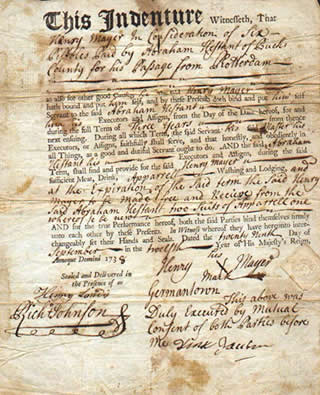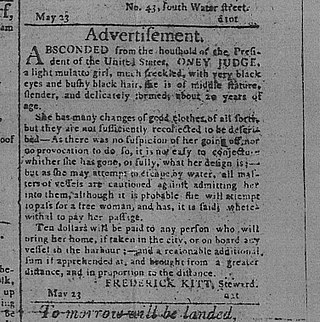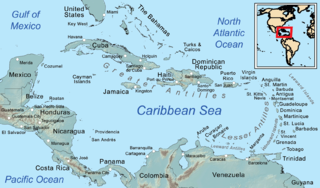
The Colony of Virginia was a British, colonial settlement in North America between 1606 and 1776.

Slavery in the colonial history of the United States refers to the institution of slavery that existed in the European colonies in North America which eventually became part of the United States of America. Slavery developed due to a combination of factors, primarily the labor demands for establishing and maintaining European colonies, which had resulted in the Atlantic slave trade. Slavery existed in every European colony in the Americas during the early modern period, and both Africans and indigenous peoples were targets of enslavement by European colonists during the era.

Redemptioners were European immigrants, generally in the 18th or early 19th century, who gained passage to the American Colonies by selling themselves into indentured servitude, to pay back the shipping company which had advanced the cost of their transatlantic voyage. British indentured servants generally did not arrive as redemptioners, after the early colonial period, due to certain protections afforded them by law. Redemptioners were at a disadvantage because they negotiated their indentures upon their arrival in America, after a long and difficult voyage, with no prospect to return to their homelands.

Indentured servitude is a form of labor in which a person is contracted to work without salary for a specific number of years. The contract, called an "indenture", may be entered voluntarily for purported eventual compensation or debt repayment, or imposed involuntarily as a judicial punishment. The practice has been compared to the similar institution of slavery, although there are differences.
A headright refers to a legal grant of land given to settlers during the period of European colonization in the Americas. A "headright" includes both the grant of land and the owner that claims the land. The person who has a right to the land is the one who paid to transport people to a colony. Headrights are most notable for their role in the expansion of the Thirteen Colonies; the Virginia Company gave headrights to settlers, and the Plymouth Company followed suit. The headright system was used in several colonies, including Maryland, Georgia, North Carolina and South Carolina. Most headrights were for 1 to 1,000 acres (4.0 km2) of land, and were granted to those who were willing to cross the Atlantic and help populate the colonies. Headrights were granted to anyone who would pay for the transportation costs of an indentured laborer. These land grants consisted of 50 acres (0.20 km2) for someone newly moving to the area and 100 acres (0.40 km2) for people previously living in the area. By ensuring the landowning masters had legal ownership of all land acquired, the indentured laborers after their indenture period had passed had little opportunity to procure their own land. This kept a large portion of the citizens of the Thirteen Colonies poor and led to tensions between the laborers and the landowners.

Partus sequitur ventrem was a legal doctrine passed in colonial Virginia in 1662 and other English crown colonies in the Americas which defined the legal status of children born there; the doctrine mandated that children of enslaved mothers would inherit the legal status of their mothers. As such, children of enslaved women would be born into slavery. The legal doctrine of partus sequitur ventrem was derived from Roman civil law, specifically the portions concerning slavery and personal property (chattels), as well as the common law of personal property; analogous legislation existed in other civilizations including Medieval Egypt in Africa and Korea in Asia.

The Chesapeake Colonies were the Colony and Dominion of Virginia, later the Commonwealth of Virginia, and Province of Maryland, later Maryland, both colonies located in British America and centered on the Chesapeake Bay.

John Casor, a servant in Northampton County in the Colony of Virginia, in 1655 became one of the first people of African descent in the Thirteen Colonies to be enslaved for life as a result of a civil suit.

Anthony Johnson was an Angolan-born man who achieved wealth in the early 17th-century Colony of Virginia. Held as an indentured servant in 1621, he earned his freedom after several years and was granted land by the colony.

Bermuda Hundred was the first administrative division in the English colony of Virginia. It was founded by Sir Thomas Dale in 1613, six years after Jamestown. At the southwestern edge of the confluence of the Appomattox and James Rivers opposite City Point, annexed to Hopewell, Virginia in 1923, Bermuda Hundred was a port town for many years. The terminology "Bermuda Hundred" also included a large area adjacent to the town. In the colonial era, "hundreds" were large developments of many acres, arising from the English term to define an area which would support 100 homesteads. The port at the town of Bermuda Hundred was intended to serve other "hundreds" in addition to Bermuda Hundred.

When the Dutch and Swedes established colonies in the Delaware Valley of what is now Pennsylvania, in North America, they quickly imported enslaved Africans for labor; the Dutch also transported them south from their colony of New Netherland. Enslavement was documented in this area as early as 1639. William Penn and the colonists who settled in Pennsylvania tolerated slavery. Still, the English Quakers and later German immigrants were among the first to speak out against it. Many colonial Methodists and Baptists also opposed it on religious grounds. During the Great Awakening of the late 18th century, their preachers urged slaveholders to free their slaves. High British tariffs in the 18th century discouraged the importation of additional slaves, and encouraged the use of white indentured servants and free labor.
During the British colonization of North America, the Thirteen Colonies provided England with an outlet for surplus population as well as a new market. The colonies exported naval stores, fur, lumber and tobacco to Britain, and food for the British sugar plantations in the Caribbean. The culture of the Southern and Chesapeake Colonies was different from that of the Northern and Middle Colonies and from that of their common origin in the Kingdom of Great Britain.

Elizabeth Key Grinstead (or Greenstead) (1630 – January 20, 1665) was one of the first Black people in the Thirteen Colonies to sue for freedom from slavery and win. Key won her freedom and that of her infant son, John Grinstead, on July 21, 1656, in the Colony of Virginia.

Indentured servitude in Pennsylvania (1682-1820s): The institution of indentured servitude has a significant place in the history of labor in Pennsylvania. From the founding of the colony (1681/2) to the early post-revolution period (1820s), indentured servants contributed considerably to the development of agriculture and various industries in Pennsylvania. Moreover, Pennsylvania itself has a notable place in the broader history of indentured servitude in North America. As Cheesman Herrick stated, "This system of labor was more important to Pennsylvania than it was to any other colony or state; it continued longer in Pennsylvania than elsewhere."

Slavery in Maryland lasted over 200 years, from its beginnings in 1642 when the first Africans were brought as slaves to St. Mary's City, to its end after the Civil War. While Maryland developed similarly to neighboring Virginia, slavery declined in Maryland as an institution earlier, and it had the largest free black population by 1860 of any state. The early settlements and population centers of the province tended to cluster around the rivers and other waterways that empty into the Chesapeake Bay. Maryland planters cultivated tobacco as the chief commodity crop, as the market for cash crops was strong in Europe. Tobacco was labor-intensive in both cultivation and processing, and planters struggled to manage workers as tobacco prices declined in the late 17th century, even as farms became larger and more efficient. At first, indentured servants from England supplied much of the necessary labor but, as England's economy improved, fewer came to the colonies. Maryland colonists turned to importing indentured and enslaved Africans to satisfy the labor demand.

Slavery in Virginia began with the capture and enslavement of Native Americans during the early days of the English Colony of Virginia and through the late eighteenth century. They primarily worked in tobacco fields. Africans were first brought to colonial Virginia in 1619, when 20 Africans from present-day Angola arrived in Virginia aboard the ship The White Lion.
John Punch was a Central African resident of the colony of Virginia who became its first enslaved person.

Indentured servitude in British America was the prominent system of labor in the British American colonies until it was eventually supplanted by slavery. During its time, the system was so prominent that more than half of all immigrants to British colonies south of New England were white servants, and that nearly half of total white immigration to the Thirteen Colonies came under indenture. By the beginning of the American Revolutionary War in 1775, only 2 to 3 percent of the colonial labor force was composed of indentured servants.

Irish indentured servants were Irish people who became indentured servants in territories under the control of the British Empire, such as the British West Indies, British North America and later Australia.

In May 1607, one hundred men and young boys were on an expedition where they arrived in what is now known as Virginia. This group were the first permanent English settlers in America. They named the colony of Jamestown, after the English King James. The site was chosen precisely for its location and beneficial factors. Jamestown was surrounded by water on three sides of the land; this made it easily accessible for ships to come and go. It was far enough inland, making it easier to defend from a possible Spanish attack. At the time, it was said that the men had to be able to create a living before any women could be a part of the colony.













